August 29, 2017
I seem to remember uttering (or at least writing) words that indicated non-precipitousness (yes, it's a word because I say so) of the Black Hills and its roads. After another foray into that region, I most adamantly retract that statement.
There were far more things we wanted to do while we were at home in South Dakota than time would allow, thus flipping a coin figuratively sent us off to the Needles Highway. First off, although it is a paved road surface, it's a bit presumptuous to call it a highway. Rather it is an extremely narrow serpentine route through a series of the most sheer perpendicular rock spires you could possibly imagine.
The result is wondrous views of rocky prominences rising abruptly skyward, compelling travelers to pull off the road at every possible opportunity to share their awe with complete strangers.
Now about that narrow road: Evidently, some civic-minded engineer decided that it would utilize far too much of the taxpayers' money to blast out tunnels wide enough through the rock to allow the passing of vehicles from both directions. Frugally enough, the aforesaid planner said something along the lines of "Let them wait." And that is how it came to be, boys and girls, that certain Black Hills tunnels accommodate only one vehicle at a time and not a very large one at that.
The needles eye (below) . . . pretty crazy, huh?
Devil's Tower. . .
We are lovin' us some Black Hills countryside, thus despite ratings at the trailhead that indicated strenuous trail conditions and despite my lack of enthusiasm at that moment for much in the line of exertion, we set off on the Little Devil's Tower route.
Although the trail took us continually upward, the incline was plenty gradual enough for my mood. The lush prairie-grass & flower-tangled bottomlands interspersed with mossy forested slopes was more than sufficient to entice me onward.
Along the way, we occasionally heard voices that sounded as if they were just beyond the trees a bit. Finally, we discerned they were climbers far at the top of rock spires. We spotted three sets of of climbers, all of whom are at the top of peaks in the photo below.
The photo below is of a Black Elk Peak fire lookout tower in the Black Elk Wilderness where we hiked. Because it's a wilderness area, there are no roads to it. The impressive edifice was built in the 1930s by the Civilian Conservation Corps. with the rocks being carted by man and mule three miles up from French Creek.
Skinning cats . . .
I never did know what is meant by the old saw about more than one way to skin a cat (betting one of my blogees is going to explain it to me) but I do know all about there being more than one way to get from here to there, and I'm a firm believer in pursuing those alternate routes.
One of our recent drives began innocently enough on a known path but detoured because of a haystack. I had been noticing that many farmers were not baling their hay but rather leaving it stacked in the field. My curiosity is still not satisfied so I will just go with my surmise on the issue: that they are doing that because they will winter pasture their stock there and hay will be readily available during those times that weather does not allow them to get out there to feed.
Because we had turned on to a side road for a haystack photo and because I wondered where that particular dirt road led, we proceeded and found that it took us right to where we intended to go and did it via a far more picturesque route.
Sylvan Lake . . .
One after another, lakes large and small dot the Black Hills countryside. One that we encountered was startling in its resemblance to our very own Watson Lake, five minutes from our Prescott home. Sylvan is quite the delight for picnickers, kakyakers and hikers. We traversed its perimeter on a trail that sent us scrambling up and over the high granite boulders that hold the water back with the assistance of a very short dam.
On the downstream side, the overflow drops through a high crack in the rocks.
Hot springs . . .
When we went to the Mammoth Site, we got a brief sight of Hot Springs' unique architecture, and returned to take a longer gander.
From about 1893 to 1911, impressive structures of Lakota sandstone were erected, ostensibly to further the town's reputation as a desirable spa resort. Everything from the courthouse and city hall to churches and commercial blocks were built in a Romanesque style featuring arcades, round arches and ostentatious ornamentation. Purportedly, they were designed and built by artisans imported from Germany. At least that's what the woman at the visitor's center said; however, she wanted to talk longer than I wanted to listen, so the rest of the story was told as I was smiling and nodding my way out the door.
The springs from which the town takes its name is a mere 87 degrees, thus is much more deserving of being called a warm spring, and barely that. Nevertheless, the mineral water has been something of a draw; folks are drawn to the historic indoor pool called Evans Plunge. I find that lukewarm water to be distinctly unattractive, minerals or not.
Not all the historic structures in Hot Springs are of limestone construction. We saw many other very interesting and attractive buildings, including the jail that was built of interlocked 2x4s laid flat.
Jewell Cave . . .
Another day, another cave, this one far prettier than Wind Cave and a more extensive tour. Neither of those caverns affords much space for groups to view, thus we often were left on a narrow walkway as the group strung out behind the guide.
I vainly attempted to snap pics without holding up the people behind me, but in the end, I was frustrated not to have better photo ops. Jewell Cave is larger even than Wind Cave and much prettier. There is strong speculation that at some point, the two are connected; however, with 90% of the passageways unexplored, there has been no confirmation of that. To date, there have been 181 miles of Jewell Cave mapped, making it the third largest in the world.
The stockade . . .
In the vein of seeing whatever is there to be seen, we stopped at something that looked like a miniature old west fortress.
Called the Gordon Stockade, it is exactly that except that of course the original fort is long gone, replaced by a replica, although I think a portion of the interior cabins are original. Very cleverly crafted roofs!
The fortress was built during the 1874 gold rush when miners came into the territory treatied to the Sioux, creating great conflict by their illegal entry into the land.
 |
| One arm of Stockade Lake extends out toward the fortress site. |
Evidently, the Glen Erin one-room schoolhouse, built in 1882, catered to more than 40 pupils at one time.
The things you see along the way . . .
Adding to the list of wildlife we saw in the Black Hills were turkeys - lots of them. Although there were not the huge herds of bison as in Yellowstone, we saw more of them singly and up close. One hike in Custer State Park gave us red-headed woodpeckers, hairy woodpecker, ruby-crowned kinglet, Say's Phoebe on the trip list.





































































